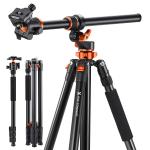Reviews
Versatile but TERRIBLE monopod screws
I am a former television director and have enjoyed astrophotography for several decades. I've been using a Bogen Manfrotto 3051 professional tripod with a 3063 head. I've used many professional tripods in my career.I ordered this K&F Concept 72 Inch Camera Tripod as my 3051 is quite heavy to pack into remote locations to do my astrophotography. This smaller and lighter tripod wants very much to be perfect but stops just a few very minor features short. That said, it does have several features not found in my 3051 that I'm liking very much. With that in mind, here are my pros and cons:PROS:• It is Lightweight. I don't mind attaching this tripod to my backpack and hiking it into location. This is one of the major selling points for me.• A very compact yet sturdy design (seem my comparison photo of this tripod next to my 3051).• Easy deployment of the multi-angle legs makes short work of getting set up.• Mostly solid aluminum construction (where it counts).• Comes with a very nice and durable carrying bag with strap. This will keep dust, dirt, and a few raindrops from getting into the tripod.• It is a solid platform for shooting astrophotography, which requires that there be no instability. I usually don't extend the third, smallest section of the legs when shooting the night sky.• It is both a monopod and tripod in one. This is a very desirable feature for me. I have a Bogen Manfrotto monopod too but with this tripod, I don't have to drag both around.• The center column can be added to the monopod to extend the height.• The center column can be inverted for doing macro photography.• The ball lock knob, when loosened, allows the center column to telescope to twice its original length. This allows you to get the camera well overhead.• It allows for landscape and portrait orientation when shooting.• The ball head makes for very quick changes in orientation. While I don't do many many orientation changes, I think it would be ideal for a wedding or landscape photographer.• The ball head has a separate knob to lock the head in the panning axis.• The ball head has a single cutout that allows you to position the camera 90° from horizontal.• The pan adjustment is calibrated in degrees. This is especially nice for shooting astrophotography because I often orient by degrees from the North. The degree tick marks properly orient along the horizon plane (45° = East, 315° = West). I always set up with the zero tick facing geographic North.• The central column rotates 360 degrees and provides a stable plane for taking panoramic shots. It also doubles as a handlebar.• It has a counter-weight hook - a feature usually found only in high-end tripods.• Most adjustment and lock knobs are metal where it is needed.• Articulation of the ball head and other moving parts of the tripod is smooth.• It supports the weight of my camera, which has a heavy battery pack.• The camera plate adjusts forward and backward to balance the camera.• The orange and black color scheme looks professional.CONS:• The camera plate needs to be a bit larger and provide a better tightening arrangement.• The leg flip locks are plastic. I see this as a potential failure point for the tripod. I hope the manufacturer sells replacements in case I drop the tripod on a rock and bust a flip lock.• The monopod lacks a quick vertical adjustment trigger. In some shooting scenarios, I would want one.• The camera plate needs a lock pin for use with video cameras to avoid loosening of the plate after numerous pans.Parting thoughts... I enjoy using this tripod and will be using it for most of my astrophotography (and other photography) in the future. It is lightweight, sturdy, and solid. The cons weren't such detractors that would cause me to take any stars off of my final five-star rating. If you want a very nice prosumer tripod, don't hesitate to buy this one.
27/01/2024

